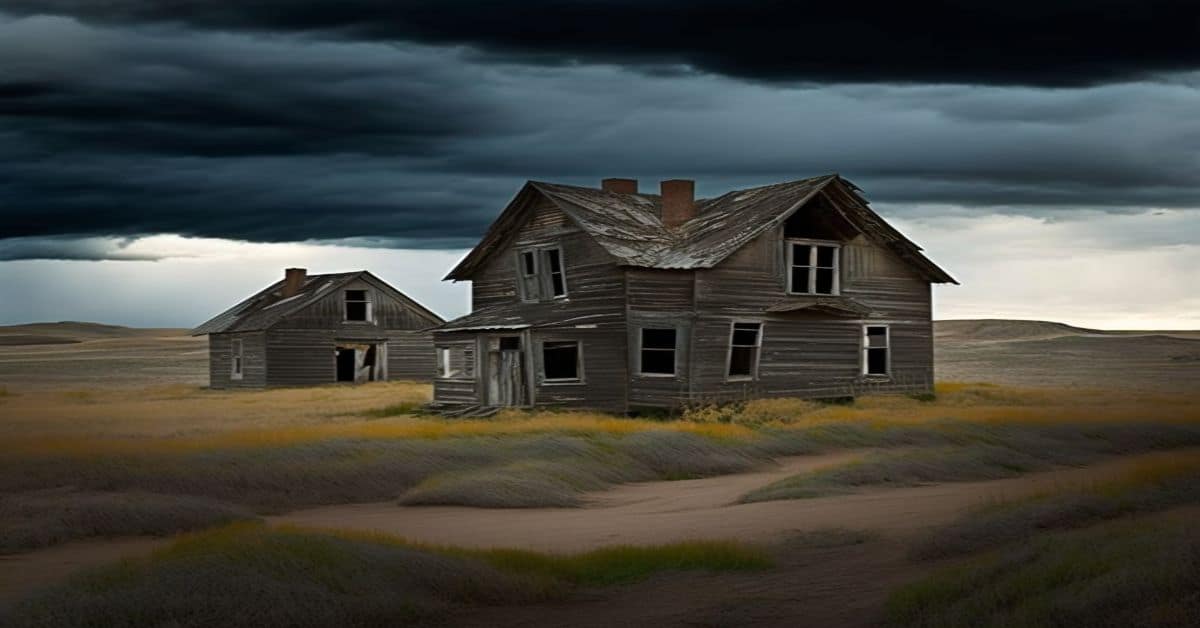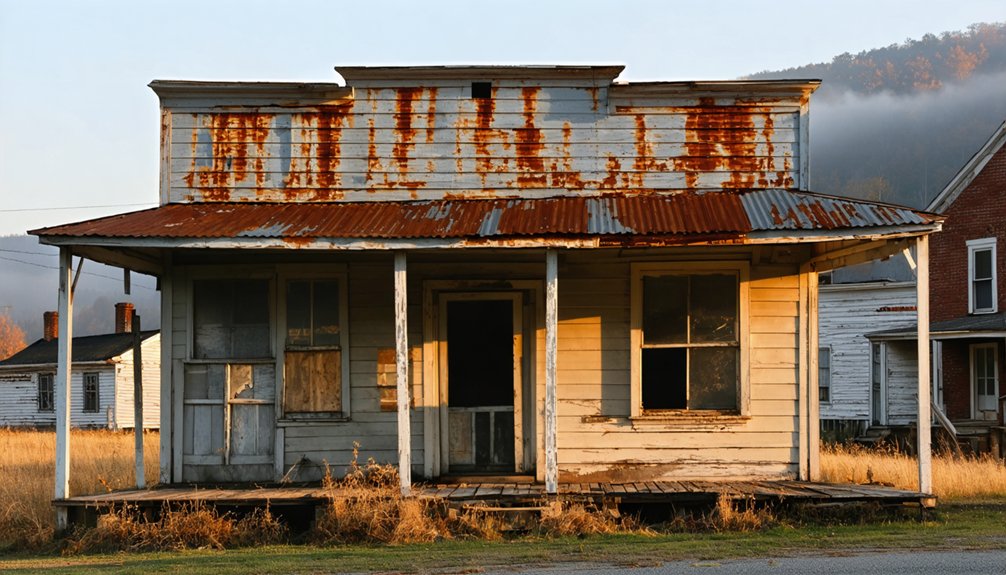You’ll find Oz tucked away along Kentucky’s riverbanks, where coal once fueled dreams of prosperity. This former mining settlement thrived in the early 1900s, complete with company stores, shared water pumps, and cramped worker housing. When environmental concerns from coal plants grew dangerous, the TVA’s buyout offers led families to abandon their homes. Today, nature reclaims the scattered foundations and rusted equipment, whispering tales of Kentucky’s rich mining heritage.
Key Takeaways
- Oz was a bustling river port in Kentucky that supported coal and timber industries before its eventual abandonment.
- Environmental concerns from coal-fired power plants made the area unsafe, forcing families to relocate.
- The Tennessee Valley Authority offered buyouts to residents, leading to the complete disbandment of the community.
- Physical structures were demolished by bulldozers, leaving only scattered foundations and mining equipment as evidence.
- Native plants now grow among the ruins, while the ghost town serves as a testament to Kentucky’s mining heritage.
The Rise of a Mining Settlement
While coal’s presence in Kentucky had been known since Thomas Walker’s discovery in 1750, it wasn’t until the 1820s that the first commercial mines began transforming the landscape.
The first mine opened in Muhlenberg County in 1820, setting the stage for Kentucky’s coal industry.
You could’ve witnessed the dramatic changes as mining technology advanced and settlements sprouted near the precious black seams beneath the earth.
When the railroads arrived in the early 1900s, they breathed new life into these humble beginnings.
You’d have seen company towns rising from nothing, their identical houses dotting the hillsides like mushrooms after rain.
Many miners found themselves trapped in a company store system that kept them in perpetual debt to their employers.
Workers from all corners of Appalachia and beyond flocked to these settlements, bringing their cultural heritage with them.
Mountain folk and valley folk alike converged on coal towns, weaving their traditions into the fabric of mining life.
The rails didn’t just carry coal – they carried dreams, hopes, and the promise of a better life, even if that promise came with strings attached.
Life in an Appalachian Coal Camp
If you’d stepped into an Appalachian coal camp in those days, you’d have found a world where company control touched every aspect of life.
You’d have lived in a cramped company shack, shopped at the company store with script money, and watched company guards patrol your streets. Your children would’ve hauled water from the common pump, while you’d have worried about making ends meet with inflated store prices eating away at your wages.
Yet despite these hardships, you’d have witnessed remarkable community resilience as families banded together, sharing what little they had.
Your neighbors would’ve understood your health struggles – the constant cough from coal dust, the aching lungs, the weary bones – because they lived it too. The ten to twelve hours of backbreaking work six days a week left little time for rest or family.
In those company-owned camps, freedom felt distant, but the human spirit never dimmed. With diverse immigrant workers from Southern and Eastern Europe filling the mines, the camps became a melting pot of languages and cultures.
Economic Backbone and Daily Operations
Back when coal was king, you’d have found Oz humming with the rhythms of industry and commerce. The local mines weren’t just holes in the ground – they were the heartbeat of economic sustainability, providing steady work for countless families who called this slice of Kentucky home.
Just as Lynch’s coal tipple could process an impressive fifteen thousand tons daily, Oz’s operations kept the coal moving at a remarkable pace. You’d see coal cars rolling down the railroad tracks while general stores bustled with activity. Local entrepreneurs ran everything from boarding houses to barbershops, creating a web of commerce that kept the community’s spirit alive. The fertile soil nearby supported many miners who supplemented their income with small farming plots.
The town’s community resilience showed in how folks supported one another, from the miners working deep underground to the shopkeepers who extended credit during lean times. Everyone played their part in keeping Oz’s economic engine running, though they couldn’t know the challenges that lay ahead.
The Path to Abandonment
Though Oz once thrived as a bustling river port shipping coal and timber across the region, you’d never know it today.
Shadows of steamboats and timber barges haunt these empty docks, where a forgotten river town once pulsed with commerce.
As railroads and highways replaced river transport, you could feel the town’s pulse growing weaker. The final blow came when those massive coal-fired power plants filled the air with thick smoke and dust, turning your hometown into a place you couldn’t safely raise your kids anymore.
When the TVA stepped in with their buyout offers, folks saw their chance to escape. One by one, families packed up their memories and scattered to the winds.
You’d watch as bulldozers erased homes, churches, and stores – the very fabric of community life. Just like in Paradise, where Peabody Coal Company transformed a once-lush landscape into a barren wasteland. A similar haunting silence fell over nearby Edmonson in 1962 when the entire population vanished mysteriously. Industrial decline swept through like a fever, leaving only the cemetery to whisper stories of what once was.
Modern Day Traces and Historical Significance
Walking through Oz today feels like trying to read a faded letter – most of the words have washed away, leaving only hints of the story.
You’ll spot scattered foundations peeking through thick vegetation, and if you’re lucky, you might stumble upon rusted mining equipment breaking through the soil like archaeological treasures.
The cultural legacy lives on through the stories passed down by miners’ descendants, while annual heritage events keep the flame of memory burning.
You’ll find more than just ghost town ruins here – you’re walking through a powerful reminder of Kentucky’s mining heritage and the spirit of Appalachian communities.
Despite the environmental impact that reshaped the landscape, nature’s slowly reclaiming her territory, with native plants taking root among the mine tailings and weathered remnants of this once-bustling town.
Like the preserved structures of Bodie State Park in California, these remnants offer glimpses into America’s rich mining history.
The area’s mining history dates back to when placer gold deposits were first discovered in 1874.
Frequently Asked Questions
Are There Any Surviving Photographs of Oz During Its Operational Years?
You won’t find any confirmed photographs from Oz’s heyday – historical archives and visual documentation haven’t turned up any surviving pictures of this fascinating little town during its operational years.
What Happened to the Mining Equipment and Machinery After Abandonment?
Ever wonder what happens when mines shut down? You’d likely find Oz’s mining legacy followed typical Kentucky patterns – equipment was either sold for scrap, hauled away, or left to decay naturally.
Did Any Famous or Notable People Ever Visit Oz?
You won’t find any records of famous visitors or notable legends tied to this remote spot – it’s one of those untouched places that stayed off the beaten path of history’s celebrities.
Were There Any Documented Paranormal Experiences in the Ghost Town?
While you’d love to hear spooky tales, there aren’t any clearly documented ghost sightings in the town itself. The surrounding area’s got plenty of local legends, but Oz’s spirits remain mysterious.
Can Visitors Legally Explore the Remains of Oz Today?
You’ll need to be mighty careful about legal access since there’s no clear public status for exploring – it’s likely on private land and you’d best get permission for visitor safety.
References
- https://pcttrailsidereader.com/post/728367010726215680/the-ghosts-of-kentucky-camp
- https://southernarizonaguide.com/kentucky-camp-az-a-ghost-town-with-accommodations/
- https://www.youtube.com/watch?v=D9gOmfCuKLs
- https://www.worldatlas.com/cities/10-famous-ghost-towns-of-america.html
- https://en.wikipedia.org/wiki/Kentucky_Camp
- https://en.wikipedia.org/wiki/List_of_ghost_towns_in_Kentucky
- https://www.freakyfoottours.com/us/kentucky/
- https://en.wikipedia.org/wiki/Coal_mining_in_Kentucky
- https://appalachiangenealogy.substack.com/p/tracing-ancestors-in-eastern-kentucky
- http://coaleducation.org/coalhistory/coaltowns/historic_context.htm



